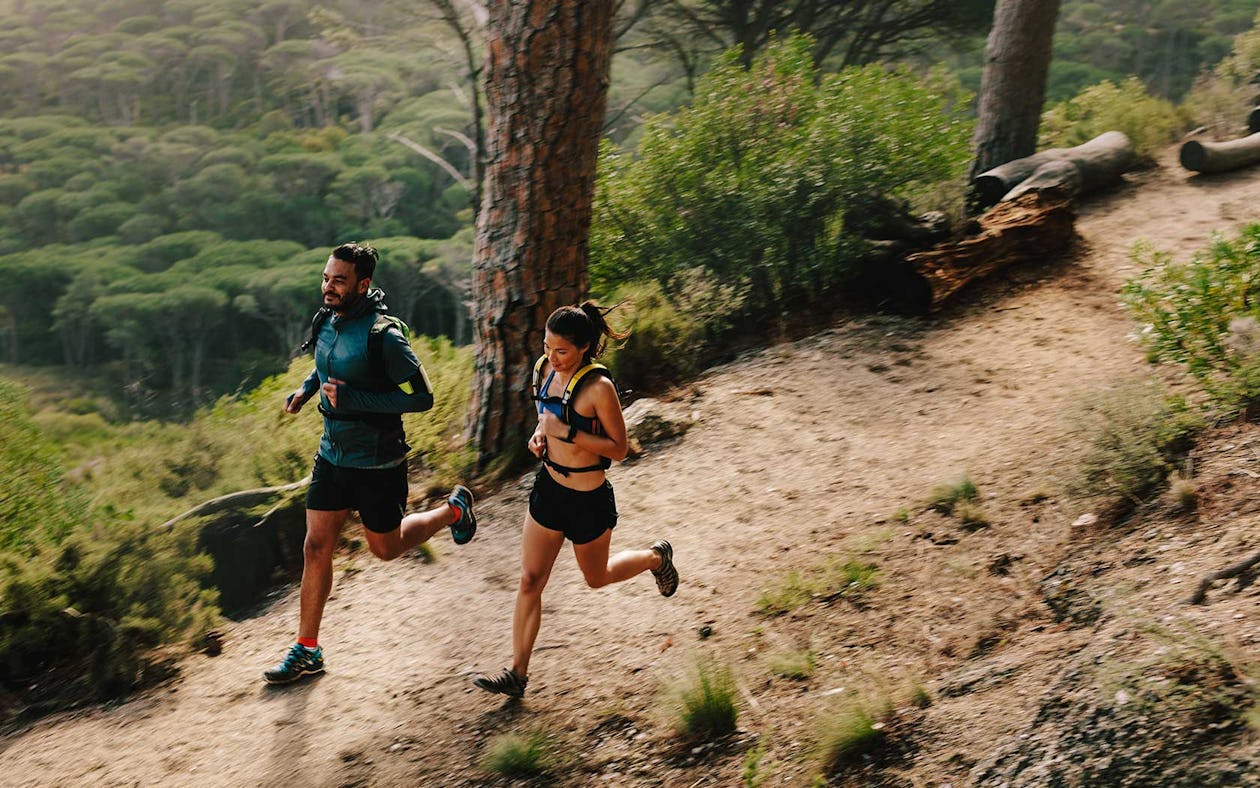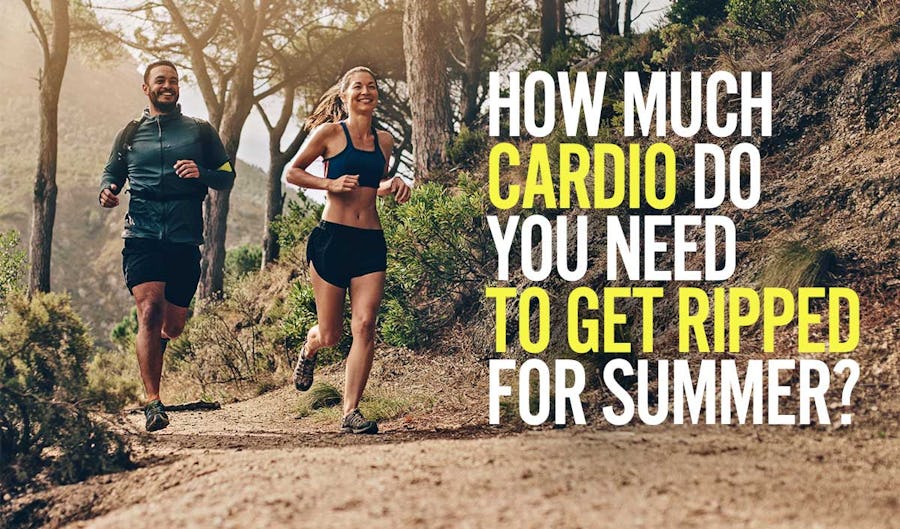Cardio. It’s good for your heart and it burns fat, and whether you love it or hate it, you know you should be doing some. But how much do you need to get lean in time for summer? And which kind should you do?
Before we answer these questions, let’s review what it takes to get ripped. First of all, you need to cut calories from your diet.
It doesn’t matter if you’re in the low-carb camp or you like to eat Froot Loops every morning (either approach can work); you need to create a caloric deficit to lose fat.
Secondly, you need to lift weights. Without strength training, dieting will leave you soft and weak—resistance exercise sends the muscles the message that they’re not allowed to burn up.
Plus, the more muscle you have, the greater your resting metabolic rate and the more calories you’ll burn daily, inside the gym and out.
That brings us to cardio. There’s aerobic (steady-state) work and interval training. Both are good adjuncts to your diet and lifting regimen, but neither contributes as much to a lean body as you probably think.
Cold, Hard Cardio Facts
Let’s look at how many calories aerobic training can burn, starting with one of the most efficient and probably the most popular form of steady-state cardio—jogging. According to research from Harvard, a 185-pound person running at an eight-minute mile pace can burn 555 calories in 30 minutes.
“Golly,” you say. “That’s a lot.”
Well, yes and no. It’s more calories than you’re likely to burn given the same amount of time lifting weights (266 calories), but, at some point in the day, you’re going to have to eat something. And that’s the problem, because it’s much easier to consume calories than it is to burn them off. Let’s say this 185-pounder follows up his run with a healthy, high-protein meal of eight ounces of skinless chicken breast, one cup of brown rice, and as much broccoli as he can fit on his plate, dressed with a mere one tablespoon of olive oil. The calorie total for that meal? Just under 600.
In other words, just one HEALTHY meal (most people don’t eat this well) pretty much cancels out the calories you burn in one intense aerobic session. Furthermore, you’re going to have to eat more than once in a day, but you’re not going to go back to the gym again and again, so it’s clear that eating even the “cleanest” foods can overwhelm your calorie-burning efforts.
“Shit,” you say. “That sucks.”
Indeed it does. But what about interval training? According to the American College of Sports Medicine (ACSM), alternating hard bouts of exercise with periods of light work or rest (which you probably know as high-intensity interval training, or HIIT) can burn more calories per minute of exercise than aerobic training. That makes it more time-efficient, but because interval sessions are more intense than aerobic ones, they can’t last as long, and that means you won’t burn more calories overall.
A study published in the American Journal of Human Biology compared steady-state training to HIIT. Subjects performed two protocols: they alternated sessions where they ran for 20 minutes straight, keeping their heart rates at a moderate level, with workouts in which they did multiple, all-out 20-meter sprints. After seven weeks, the total exercise time in the jogging workouts was naturally much greater, and so were the calories burned: approximately 4,410 calories from the steady state training versus only 907 for the HIIT.
You may have heard of a phenomenon called EPOC—excess post-exercise oxygen consumption. This is the period after a workout where your body is recovering from the session and burns calories at a faster rate compared to a resting state. Some trainers like to make a big deal about EPOC, arguing that it’s better than steady-state cardio because it allows you to burn calories when you’re not doing anything (similar to the effect that building muscle has on the metabolism). But the truth is, the effect of EPOC isn’t that dramatic. According to the ACSM, it’s actually quite “modest,” burning only about six percent more calories than you burned in the workout itself (more if you went extremely hard—harder than most people are capable of—but still not a lot).
So what are we saying? Is cardio a huge waste of time?
Of course not. It still burns fat and increases endurance and, more importantly for your health, it strengthens your heart, lowers blood pressure, helps you recover from weight training more quickly, and a host of other good things. But the fact remains that exercise of any kind—when done independently from diet changes—just doesn’t make much of a difference for weight loss. A study from the journal Obesity looked at obese women who either dieted, exercised, or combined diet and exercise to lose weight over the course of one year. Unsurprisingly, the exercise-plus-diet group lost the most weight at about 20 pounds (and nearly six percent body fat). But the women who dieted alone weren’t far behind with around 15 pounds lost (and four percent body fat). And the exercise-only group? A mere four pounds and a little more than one percent body fat.
All of this means that lifting weights and doing cardio is well and good, but unless you’re eating less food than you were last month, the only six-pack you’ll see will be from Budweiser.
For ideas on setting up an effective diet, click HERE.
How Much Cardio You Need, and How To Do It
Now, to answer the questions at the beginning of this article (yes, we know that was a long time ago)…
How much cardio do you need to get ripped?
The answer: Not as much as you think.
And which kind should you do?
The answer: All of it.
Let us explain.
Assuming you’re cutting calories and lifting weights three to four days per week (three is the minimum amount that most trainers say you need to see progress), you only need about three cardio days per week to see your abs. That’s the recommendation of Don Saladino, a New York City-based trainer to celebrities like Ryan Reynolds and Blake Lively.
On each cardio day, do a different type of cardio. But wait, aren’t there only two kinds—steady state and intervals?
Actually, “there are three forms of cardio,” says Saladino. “You’ve got your steady state, your HIIT, and then there’s medium-intensity.” This last category is what most people think of as HIIT, but it really isn’t. “People tell me, ‘I do HIIT training—I run for 30 seconds and then walk 30.’ And I say, ‘No, you don’t. You do medium-intensity,’” which is the gray area in between true HIIT and aerobic work.
Medium-intensity intervals could be alternating fast runs with walking. They could be jumping rope, doing battle rope waves, running through a circuit of bodyweight exercises, or anything else that gets your heart rate up high and lets you sustain it for a little while, recover a bit but not fully, and go again.
This differs from textbook HIIT, which is work that is so demanding that you can only sustain it for four to six seconds. We’re talking a full-on sprint, battle rope slams, or pedaling on an Airdyne bike like a UFC fighter. Because it’s so hard on your nervous system as well as your muscles, Saladino says you should limit HIIT sessions to twice a week.
Finally, there’s steady-state cardio, where all you have to do is get your heart rate between 120 and 150 beats per minute and keep it there for 30–60 minutes. You could do this kind of training virtually every day if you wanted, but for the purposes of getting ripped, one day a week is enough when done in combination with HIIT and medium-intensity intervals.
Each cardio type trains a different energy system, so each is important to develop for well-rounded fitness, but none can replace weight training and diet when it comes to getting beach-ready abs. See the full directions on how to implement each cardio method below, and enjoy your summer.
HIIT
Frequency: 1–2x per week
Exercises: sprints, hill sprints, exercise bike sprints, Versaclimber sprints, battle rope slams
How to do it: warm up, then work as hard as possible for 4–6 seconds. Rest until you feel ready to repeat the effort.
Workout time: 12–15 minutes
Medium-Intensity Intervals
Frequency: 2–3x week
Exercises: fast treadmill jogs, rope jumping, body-weight circuits, sled pushes, battle rope waves
How to do it: make up your own intervals. Any hard but not maximal pace for the work interval will do. Alternate that with active recovery. For example, jump rope for 60 seconds and stretch your hip flexors for 30 seconds.
Workout time: 15–30 minutes
Steady-State Cardio
Frequency: 1–3x per week
Exercises: jogs, cycling, swimming, hiking
How to do it: work at a pace that keeps your heart rate between 120 and 150 beats per minute. You can wear a heart rate monitor or estimate as follows. Subtract your age from 220 to find your approximate maximum heart rate. Now place your index and middle fingers on the pulse in your neck and count for six seconds. Multiply that number by 10 to get your heart beats in a minute.
Workout time: 30–60 minutes
For more about Don Saladino, visit donsaladino.com
Additional reporting by Vince Kreipke, Ph.D.




)






